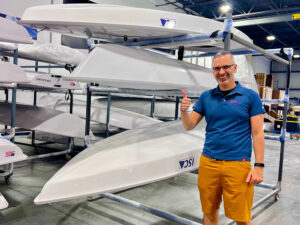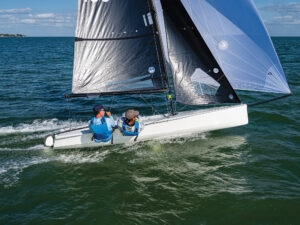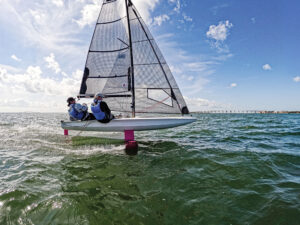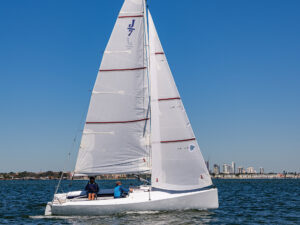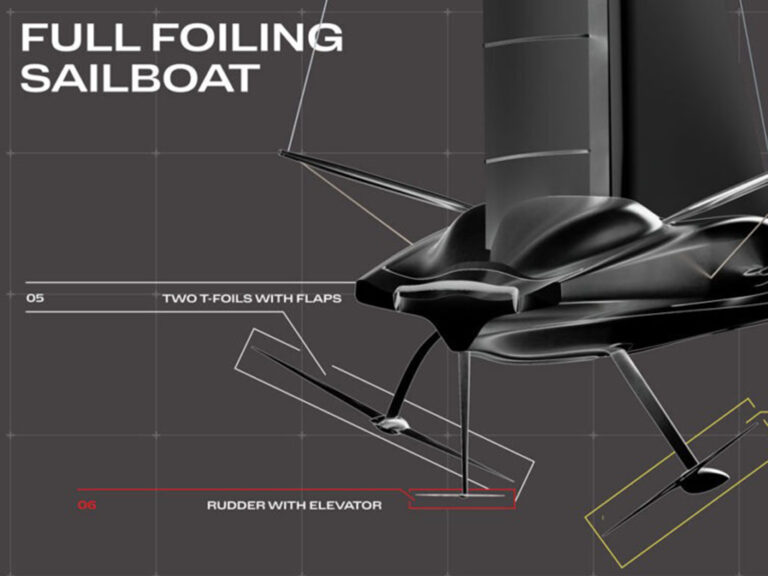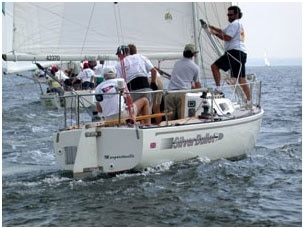
J/30St
The cheapest way to race is on someone else’s boat. But if you have dreams of thrusting the silver urn aloft at the awards banquet while praising your crew, you’ll have to buy your own ride. The one thing standing in the way, you say, is the expense. But with handicap racing, you don’t have to spring for a big-ticket racer. There are many competitive and cheap sailboat designs you can buy and campaign for the cost of a new sport utility vehicle.
The most popular rating rule in the United States is the Performance Handicap Rating Fleet. So, if you’re interested in buying a used boat, and want plenty of opportunity to race, it not only makes sense to buy one from a manufacturer that fits your budget, but also performs well under PHRF rating. You want a sailboat that rates well in your region, but you don’t want to sail a dog. A simple, but effective way of measuring a boat’s abilities without sailing it is to determine its sail-area-to-displacement ratio. On most boats, the SA/D ratio usually works out to be between 14 and 30, with higher numbers representing lighter, faster boats. Cruiser/racers have ratios between 16 to 20, racer/cruisers have ratios greater than 20, and high-performance racers have ratios 24 and above. A SA/D calculator can be found at
Thanks to the Internet, searching for one of the best PHRF boats is more fun than work, but to narrow down your search we’ve tapped our resources to find 16 of the best racing sailboats that shouldn’t be overlooked.
Assuming you happen to have enough room in your household budget for a good-sized car payment, you might consider the following scenarios: 1. You could buy a new Chevy Tahoe for $36,000, and with zero down and zero percent financing over 36 months, you’d pay $1,000 per month. When you’re all paid-up, you’d still have the car, but you’d be no closer to tiller time. 2. You could keep your old beater and buy a PHRF racer for $26,000. Put down 10 percent, finance it at 7.75 percent over 10 years, and for roughly $280 per month, you’d be the one calling the shots.
Boat loan: Base price for the boat = $25,857 – $2,585.70 (10 percent down payment) = $23,271.30 @ 7.75 percent for 10 years = $279.28 per month
Before you go blazing off to your nearest yacht broker, consider that used boats may require a few structural or equipment upgrades. The list can be quite extensive and range from new sails and electronics, to a professional bottom job, to new running rigging; there’s always something that you need or want to buy before you get on the water with your new boat. Using an average $5,000 upgrade budget estimated by boat owners on Sailing World’s online Racing Forum, let’s add that to the purchase price of a 27- to 35-foot boat and recalculate the payment using a slightly lower 7.5 percent rate. Most lenders change their rates if you borrow more than $25,000. There’s a useful boat loan calculator online at http://www.iamfinancing.com/Boats.html
Upgrades: Base price $25,857 + 5,000 upgrade = $30,857 – (10 percent down payment) 3,085.70 = total amount financed $27,771.30 @ 7.5 percent for 10 years = $329.65 per month
That’s still not too bad, but we’re not done yet. You need to consider seasonal operating expenses: mooring fees, insurance, race fees, maintenance and repair, launching, hauling, and storage. And, of course, most of these fees are concentrated in a five- or six-month racing season. Using a moderate operating budget of $6,000, we add it all up.
Operating costs: Annual racing budget = $6,000 ($500 per month) + 329.65 (loan payment) = $829.65
All of the above pricing information was culled from participants on the SW’s online Forum () who discussed their own favorite, affordable PHRF racers, and provided real budget numbers. What follows is a list of 16 budget racers with estimates of the first year’s average monthly budget. This includes: purchase price, upgrades typical of the individual design, and a moderate seasonal operating expense, determined to be one new sail per year with some professional labor. High-end expenses would include new sails every year and maintenance by a yard. The bare-bones budget doesn’t include any new sails and expects the owner to do all the maintenance.
We solicited info on boats whose characteristics make them competitive in handicap racing while staying within our new SUV budget guideline. Many of these boats have established one-design class racing opportunities that may, in your eyes, make them more valuable. But remember that more racing usually means a bigger operating budget. We also acknowledge that there may be less expensive ways to finance the boating lifestyle but we think these are fairly realistic expenses gleaned from experienced racers.
The Boats:
B-25
C&C 27 Mark V
C&C 35
Evelyn 32-2
J/27
J/29
J/30
J/35
Martin 242
Pearson Flyer
Pearson 30
Olson 30
S2 9.1
Santana 20
Santana 30/30
Ultimate 20

